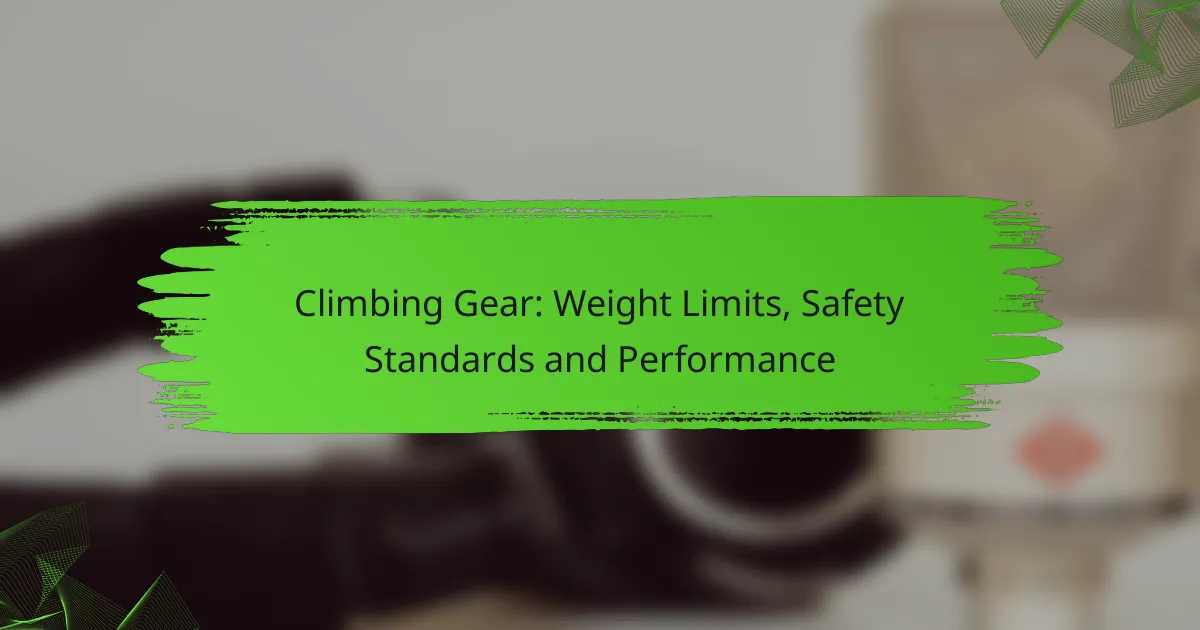Understanding the weight limits and safety standards of climbing gear is essential for ensuring a safe and successful climbing experience. Each piece of equipment, from ropes to harnesses, has specific limits that must be adhered to in order to maintain optimal performance and safety. Additionally, key performance factors such as durability and weather resistance play a significant role in the reliability of climbing gear, making informed choices vital for climbers of all skill levels.

What are the weight limits for climbing gear?
The weight limits for climbing gear vary by type and are crucial for ensuring safety. Each piece of equipment, from ropes to harnesses, has specific limits that should not be exceeded to maintain performance and safety standards.
Dynamic rope weight limits
Dynamic ropes are designed to stretch under load, which helps absorb the energy of a fall. Most dynamic ropes have a weight limit ranging from 240 to 300 kg (about 530 to 660 lbs) for a single rope, depending on the manufacturer and specific model. Always check the rope’s specifications before use to ensure it meets your climbing needs.
Static rope weight limits
Static ropes, which do not stretch significantly, are typically used in situations like rappelling or hauling gear. The weight limits for static ropes generally fall between 200 to 300 kg (approximately 440 to 660 lbs). It’s essential to consider the intended use, as exceeding these limits can lead to equipment failure.
Harness weight limits
Climbing harnesses come with specific weight limits that usually range from 100 to 150 kg (about 220 to 330 lbs). These limits include the weight of the climber plus any gear they carry. Always refer to the manufacturer’s guidelines to ensure your harness is suitable for your weight and gear load.
Carabiner weight limits
Carabiners are rated for strength, typically indicated in kilonewtons (kN). Most climbing carabiners have a weight limit of around 20 to 30 kN, which translates to approximately 2,000 to 3,000 kg (about 4,400 to 6,600 lbs). Check the specifications for each carabiner, as using one that is not rated for your load can lead to dangerous situations.
Helmet weight limits
Climbing helmets are designed to protect against falling objects and impacts. While they do not have a specific weight limit like other gear, they must fit securely and comfortably on the head. Ensure that the helmet meets safety standards such as EN 12492 or UIAA 106, which indicate it can withstand certain impact forces.

How do safety standards impact climbing gear?
Safety standards are crucial for ensuring that climbing gear meets specific performance and safety requirements. These standards help climbers choose reliable equipment that can withstand the stresses of climbing while minimizing risks of failure.
UIAA certification for climbing gear
The UIAA (International Climbing and Mountaineering Federation) certification indicates that climbing gear has undergone rigorous testing for safety and performance. Gear that carries this certification has met specific criteria for strength, durability, and functionality, making it a trusted choice for climbers.
When selecting gear, look for the UIAA label, especially on items like harnesses, ropes, and carabiners. This certification ensures that the equipment can handle the demands of climbing, providing peace of mind during your ascent.
CE marking significance
The CE marking signifies that climbing equipment complies with European safety standards. This mark is essential for gear sold in Europe, indicating that it has been tested for safety and meets the necessary performance criteria.
For climbers in Europe, checking for the CE mark is vital. It ensures that the gear adheres to regulations that protect users from potential hazards, such as equipment failure during critical moments.
ASTM standards for climbing equipment
ASTM (American Society for Testing and Materials) standards provide guidelines for the performance and safety of climbing gear in the United States. These standards cover various equipment types, including ropes, harnesses, and protection devices, ensuring they meet specific safety benchmarks.
When purchasing climbing gear in the U.S., look for products that comply with ASTM standards. This compliance indicates that the gear has been tested under controlled conditions, ensuring reliability and safety during use.

What performance factors should be considered in climbing gear?
When selecting climbing gear, key performance factors include durability, weather resistance, and ease of use. These elements significantly impact safety and efficiency during climbs, making them crucial for both beginners and experienced climbers.
Durability of climbing gear
Durability refers to how well climbing gear withstands wear and tear over time. High-quality materials like nylon and Dyneema are commonly used for harnesses and ropes, offering strength and longevity. Always check for certifications, such as UIAA or CE, which indicate that the gear meets safety standards.
Consider the type of climbing you will be doing; for instance, gear used for sport climbing may experience different stresses compared to gear used for alpine climbing. Regularly inspect your equipment for signs of damage, such as fraying or abrasion, and replace any worn items promptly.
Weather resistance of climbing equipment
Weather resistance is essential for climbing gear, especially in unpredictable environments. Look for equipment that is designed to repel water and resist extreme temperatures, which can affect performance and safety. For example, waterproof jackets and breathable fabrics can help keep you dry and comfortable during wet conditions.
Additionally, consider the gear’s ability to perform in various weather conditions. For instance, climbing shoes with rubber soles provide better grip in wet conditions, while insulated layers are crucial for cold weather climbs. Always check the manufacturer’s specifications for weather resistance ratings.
Ease of use in climbing gear
Ease of use refers to how intuitive and straightforward the gear is to operate. Features like quick-release buckles and adjustable straps can enhance usability, allowing climbers to focus on their ascent rather than struggling with their equipment. Familiarize yourself with your gear before heading out to ensure you can use it effectively.
Training and practice are vital; consider participating in climbing workshops or courses to improve your skills with various gear types. Remember, well-designed gear can significantly reduce the time spent on setup and increase your overall climbing efficiency.

What are the best climbing gear brands for safety and performance?
The best climbing gear brands prioritize safety and performance, ensuring that climbers can trust their equipment. Notable brands include Petzl, Black Diamond, and Scarpa, each offering a range of products designed to meet rigorous safety standards while enhancing climbing efficiency.
Petzl climbing gear overview
Petzl is renowned for its innovation in climbing gear, particularly in harnesses, helmets, and carabiners. Their products are designed with user safety in mind, often exceeding industry safety standards. For example, their harnesses typically feature adjustable leg loops and gear loops for convenience and security.
When selecting Petzl gear, consider the specific climbing activity. Their lightweight helmets are ideal for sport climbing, while their durable harnesses cater to both trad and alpine climbing. Always check for the CE and UIAA certifications to ensure compliance with safety regulations.
Black Diamond product range
Black Diamond offers a comprehensive range of climbing gear, including protection devices, climbing shoes, and apparel. Their gear is designed for both performance and safety, with products like the Camalot C4, which features a dual axle for improved stability and strength.
For climbing shoes, Black Diamond provides options suitable for various terrains, from bouldering to sport climbing. Look for features such as rubber quality and fit, which significantly impact performance. Always try shoes on before purchasing to ensure a proper fit, as this can enhance safety and comfort during climbs.
Scarpa climbing shoes analysis
Scarpa is a leading brand in climbing footwear, known for its high-quality climbing shoes that balance comfort and performance. Their shoes often feature advanced rubber technology for superior grip and durability, making them suitable for a range of climbing styles.
When choosing Scarpa climbing shoes, consider the fit and the type of climbing you will be doing. For instance, their aggressive models are ideal for sport climbing, while more moderate options are better for trad climbing. Always check the shoe’s sizing guide, as Scarpa shoes can vary in fit compared to other brands.

How to choose climbing gear based on weight limits?
Choosing climbing gear based on weight limits is crucial for safety and performance. Each piece of equipment has a specified weight capacity that must be adhered to in order to ensure reliability and prevent accidents.
Assessing personal weight for gear selection
Start by determining your total weight, including any additional gear you plan to carry. This total weight should fall well below the maximum limits of the climbing equipment. For example, if a harness has a weight limit of 100 kg, and you weigh 80 kg, you should account for any extra gear to ensure you remain within safe parameters.
Consider the weight of your climbing shoes, ropes, and other accessories when calculating your total load. It’s advisable to keep your total weight at least 10-15% below the gear’s maximum limit to allow for fluctuations in weight, such as clothing or hydration.
Choosing gear for specific climbing types
Selecting the right gear varies depending on the type of climbing you intend to do, such as sport climbing, trad climbing, or bouldering. For instance, sport climbing gear often has higher weight limits due to the dynamic forces involved, while bouldering gear may prioritize lightweight options for ease of movement.
Always check the specifications of climbing gear against the demands of your chosen activity. For example, a climbing harness designed for sport climbing may have a different weight capacity than one intended for mountaineering. Ensure that the gear you select is suitable for both your weight and the specific climbing discipline to maximize safety and performance.

What are the prerequisites for using climbing gear safely?
To use climbing gear safely, climbers must understand the equipment’s weight limits, adhere to safety standards, and possess the necessary skills and training. Proper knowledge and preparation significantly reduce the risk of accidents while climbing.
Understanding climbing techniques
Effective climbing techniques are crucial for safety and performance. Climbers should be familiar with various styles, such as bouldering, sport climbing, and traditional climbing, each requiring different skills and gear. Mastering techniques like foot placement, body positioning, and efficient movement can enhance stability and reduce fatigue.
Practicing these techniques in controlled environments, such as climbing gyms, allows climbers to refine their skills before tackling outdoor routes. Regularly assessing and improving technique can lead to better climbing efficiency and safety.
Training requirements for climbers
Climbers should engage in both physical and technical training to prepare for climbing activities. Strength training, flexibility exercises, and endurance workouts are essential for building the physical capacity needed for climbing. Additionally, practicing specific climbing drills can enhance skills and confidence.
Consider enrolling in climbing courses or workshops that focus on safety, gear usage, and climbing techniques. These programs often cover essential topics such as knot tying, belaying, and risk management, ensuring climbers are well-prepared for various climbing scenarios.



